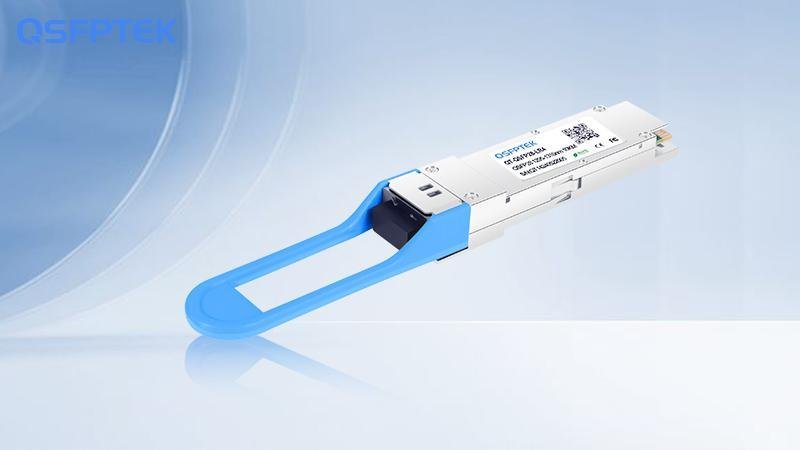The advent of 5G technology is set to transform the way we connect and interact with the digital world. With promises of ultra-fast download speeds, near-zero latency, and the ability to support an immense number of connected devices, 5G networks are expected to play a pivotal role in the development of industries such as autonomous vehicles, smart cities, healthcare, and more. Behind the scenes, technologies like 100G QSFP28 optical modules are driving the evolution of 5G, ensuring that the infrastructure can handle the enormous data and speed demands of this next-generation network.
The Role of 100G QSFP28 in 5G Network Infrastructure
One of the key challenges of 5G networks is the need for extremely high-speed data transfer. 5G networks are expected to carry massive amounts of data to support applications like real-time video streaming, virtual reality (VR), and the Internet of Things (IoT). The 100G QSFP28 optical module is designed to address this challenge by providing the necessary bandwidth to handle high-volume, high-speed data transmission across the network.
The 100G QSFP28 enables 100 Gbps data transfer rates, offering significantly higher capacity compared to previous generation modules. This capability is crucial for 5G networks, which require substantial data bandwidth to meet the demands of various applications. For example, edge computing in 5G deployments relies heavily on fast data processing at the network edge, reducing latency and improving overall network efficiency. The 100G QSFP28 plays a critical role in ensuring that data can be transmitted rapidly across different parts of the network, supporting the seamless delivery of services like cloud gaming and real-time analytics.
Enhancing Mobile Internet Experience with 100G QSFP28
One of the major promises of 5G is a vastly improved mobile internet experience. The transition from 4G to 5G will bring faster download and upload speeds, reduced latency, and a more reliable network, which are all essential for today’s mobile applications. The 100G QSFP28 module plays a significant role in delivering these enhancements, particularly in the backhaul network, which connects mobile towers to the core network.
The 100G QSFP28 ensures that mobile devices, whether in urban or rural areas, can access the high speeds and low latency offered by 5G networks. It does this by providing the necessary high-bandwidth connections between 5G base stations and core network components. By supporting the high data rates that 5G requires, the 100G QSFP28 helps deliver faster internet speeds for end users, enhancing the overall mobile internet experience. This is particularly important for applications such as 4K/8K video streaming, immersive augmented reality (AR) and virtual reality (VR), and high-performance cloud computing, which are all expected to be key drivers of 5G traffic.
Moreover, 100G QSFP28 supports the massive number of connected devices that 5G enables. The Internet of Things (IoT) is set to expand dramatically with 5G, and the network infrastructure must be capable of handling this growth. The 100G QSFP28 helps address this by ensuring that there is sufficient bandwidth to support billions of devices communicating simultaneously, while maintaining the high-speed and low-latency requirements essential for IoT applications like smart cities and connected cars.
100G QSFP28 in Supporting 5G Network Architecture
A key aspect of 5G network architecture is its multi-tiered structure, which includes the fronthaul, midhaul, and backhaul components. Each of these components plays a vital role in ensuring that 5G networks deliver the promised high speeds and low latency. The 100G QSFP28 is integral to this architecture, as it supports high-bandwidth, low-latency connections between the different network layers.
In the fronthaul, 100G QSFP28 connects remote radio units (RRUs) to baseband units (BBUs), ensuring the transmission of large amounts of data between these components. This is particularly important in 5G deployments that rely on distributed antenna systems (DAS) and small cells, as these systems require high-speed, low-latency backhaul connections to operate efficiently.
In the midhaul, the 100G QSFP28 provides connectivity between central offices (COs) and data centers, ensuring the seamless flow of data between these critical network locations. This part of the network is essential for processing the data collected from various 5G devices and applications, and the 100G QSFP28 ensures that the data can be transmitted quickly and reliably.
Finally, in the backhaul, which connects the core network to the edge, the 100G QSFP28 supports the transmission of massive amounts of data to ensure that user traffic is handled efficiently. Whether it is for video conferencing, real-time remote diagnostics in healthcare, or autonomous vehicle communication, the backhaul infrastructure needs to handle large-scale data transfer, and the 100G QSFP28 provides the necessary bandwidth.
The Synergy Between 100G QSFP28 and 5G Technologies
The synergy between 100G QSFP28 modules and 5G technologies is a key enabler of the next generation of wireless networks. The 100G QSFP28 integrates seamlessly with other 5G components, including small cells, macro cells, and network functions, to provide the necessary performance to meet the demands of 5G applications.
As 5G networks are deployed globally, the 100G QSFP28 helps eliminate network bottlenecks by enabling high-bandwidth connections across the entire infrastructure. This ensures that the network can handle the massive traffic loads that 5G will generate, particularly in densely populated urban areas where high device density is expected. By minimizing congestion and ensuring smooth data transfer, the 100G QSFP28 module contributes to the overall efficiency and reliability of 5G networks.
Conclusion
The 100G QSFP28 transceiver is poised to play a significant role in the evolution of 5G networks, offering the high-speed, low-latency connections necessary for the next-generation of communication technologies. By enabling fast data transfer across the fronthaul, midhaul, and backhaul layers of the 5G architecture, the 100G QSFP28 ensures that 5G networks can meet the demands of high-bandwidth applications, massive device connectivity, and ultra-low-latency communication. As 5G networks continue to expand, the 100G QSFP28 will be a critical component in supporting the transformative potential of 5G, driving the next wave of digital innovation.



